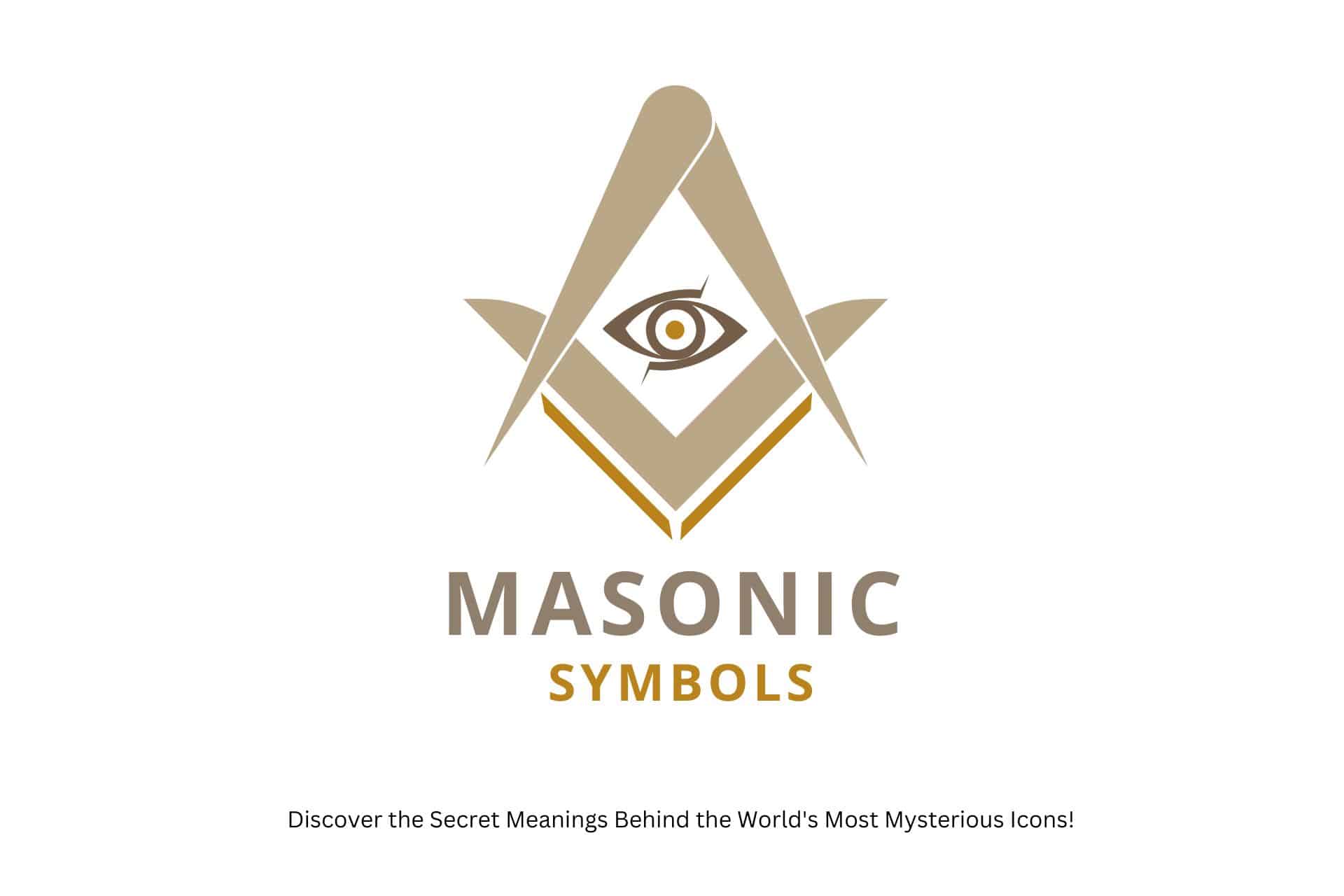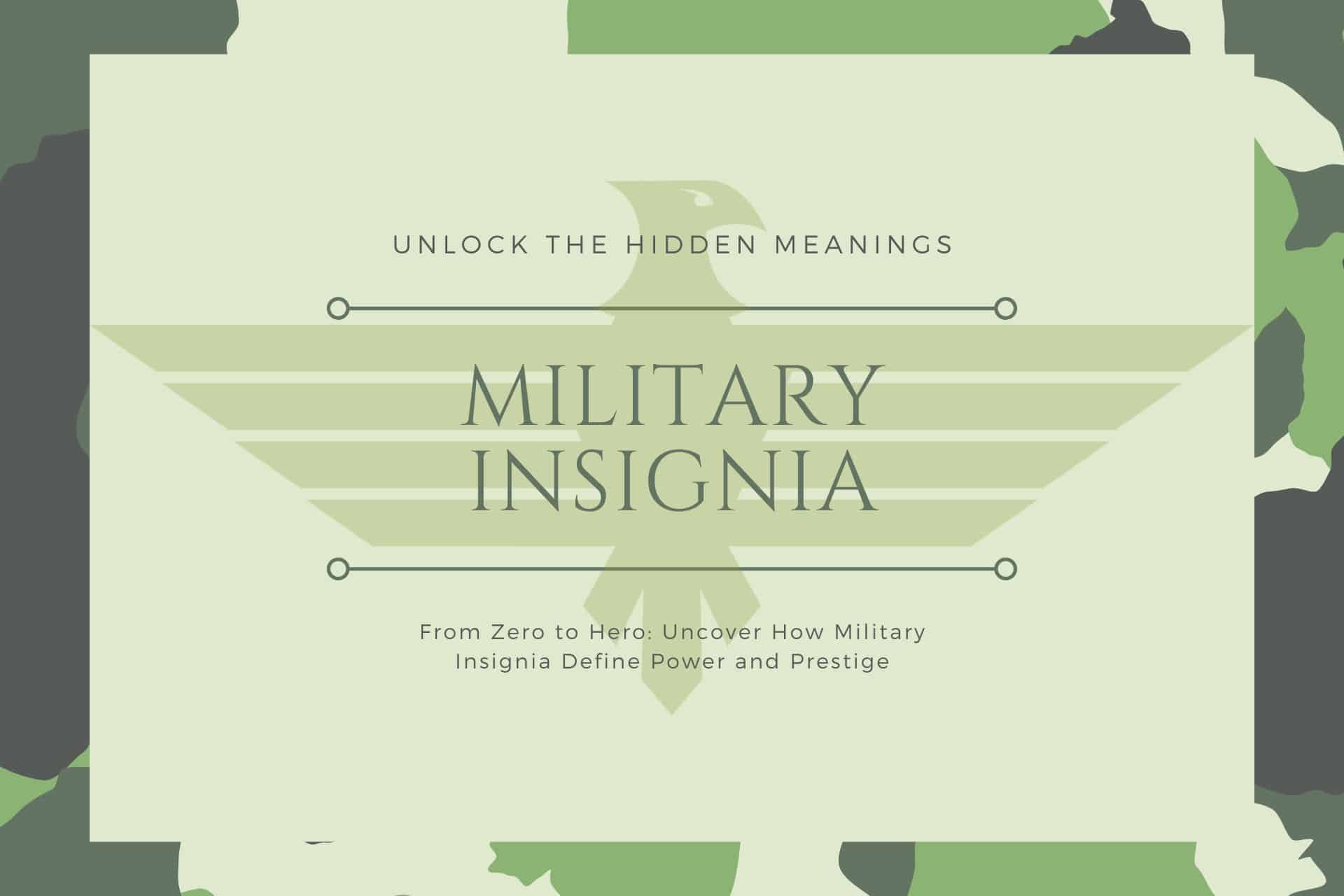Are you curious about the layers of meaning hidden within the symbols we encounter daily?
Whether deciphering ancient hieroglyphs or understanding the significance behind a modern emoji, symbolism is a vast and intrigue-filled world.
Have you ever wondered about the deeper meanings of these ubiquitous signs or how they shape our culture and communication?
This article will guide you through symbols‘ fascinating history, significance, and global variations, giving insights into their decisive role in human expression.
Prepare to unlock the secrets behind the symbols surrounding us and discover their profound impact on our world.
Continue reading to embark on this enlightening journey into the heart of symbolism and enrich your understanding of this captivating topic.
Let’s get started!
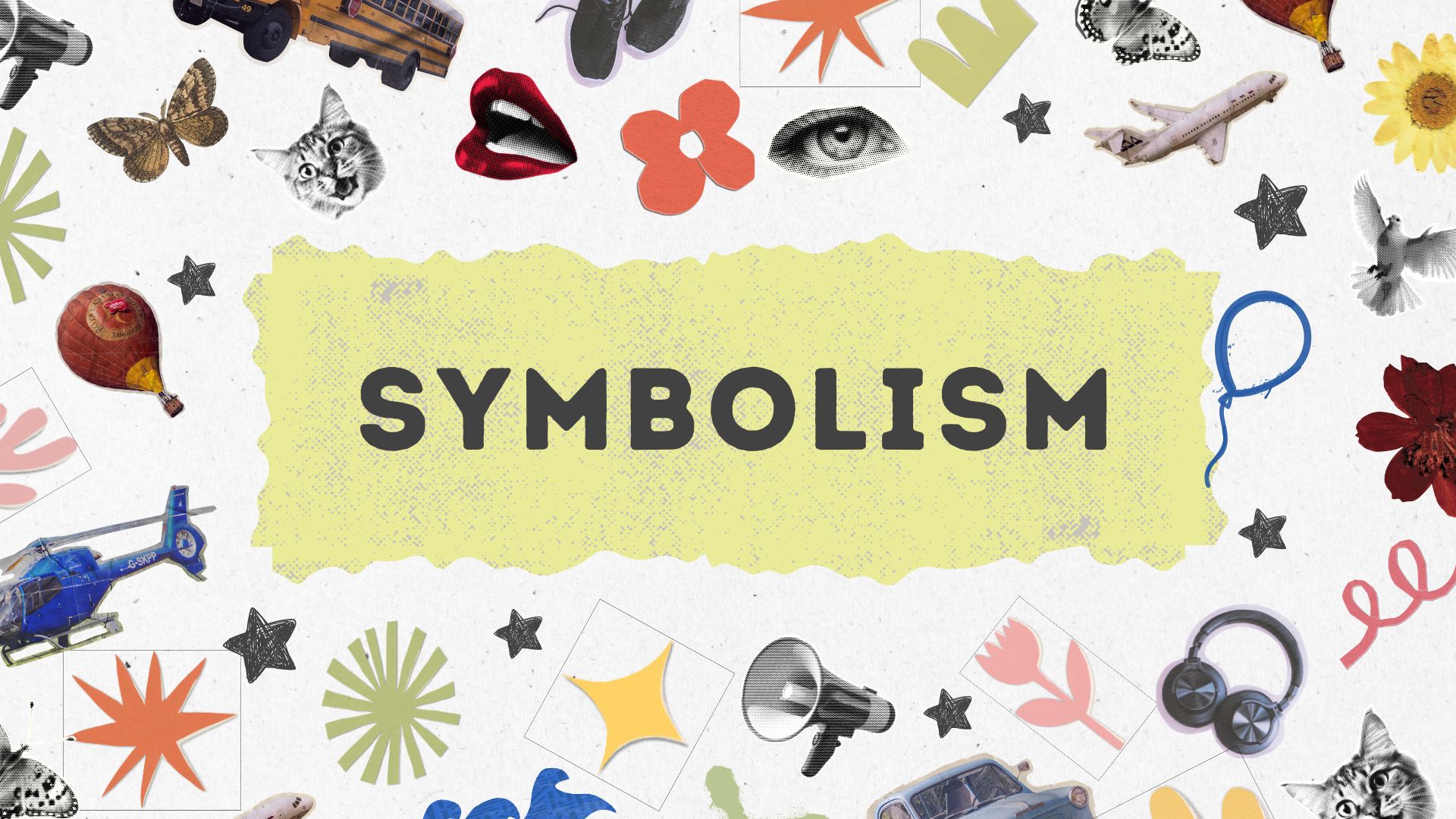
Here’s What You Will Find

Key Takeaways
Symbolism
Symbolism is a Universal Language: Symbolism transcends spoken language, offering a means to communicate complex ideas, emotions, and values through simple, recognizable symbols. It’s a universal language that connects us across cultures, time, and individual experiences.
Symbols Enrich Our World: From cultural and religious emblems to personal and literary motifs, symbols add depth and meaning to our surroundings, art, and narratives. They enrich our world by allowing us to express and interpret layers of meaning beyond the literal.
Understanding Context is Key: The meaning of a symbol can vary greatly depending on its cultural, historical, and personal context. Grasping the context in which a symbol is used is crucial to interpret its intended message and significance accurately.
Symbolism Invites Exploration and Connection: Using symbols encourages us to explore the deeper aspects of our humanity and the world around us. It invites us to connect with others through shared meanings and reflect on our beliefs, values, and experiences.
What is Symbolism?
Definition of Symbolism
Symbolism is a multifaceted concept that operates on various levels across human experience, blending art, culture, communication, and psychology into a rich tapestry of meaning. At its essence, symbolism involves using symbols—objects, figures, colors, or even actions—that stand in for or represent abstract ideas, concepts, or other phenomena. Unlike direct language, which communicates ideas explicitly, symbolism conveys messages, emotions, and ideas indirectly, tapping into the deeper layers of human consciousness and shared cultural understandings.
What is Symbolism?
Symbolism involves using symbols to represent ideas, beliefs, or entities in a way that carries more profound significance beyond their surface meaning.
Symbols serve as conduits for various communications and interpretations, bridging the gap between the tangible and intangible. They enable us to convey complex concepts and emotions efficiently and powerfully, often with a single image, object, or gesture.
The power of a symbol lies in its ability to encapsulate dense, complex ideas into a form that is immediately recognizable and emotionally resonant.
This linguistic and cognitive shorthand allows for expressing and communicating ideas that might otherwise be difficult or impossible to articulate directly. Symbols are not static; their meanings can evolve over time, influenced by cultural shifts, historical contexts, and individual interpretations.
Essence of Symbolism
Symbolism allows for expressing complex and nuanced ideas in a form that can be universally recognized or personally significant. It transcends language and literacy barriers, offering a universal language that can convey shared human experiences or deeply personal journeys.
Through symbols, abstract concepts like love, courage, danger, or purity can be communicated across cultures and epochs, sometimes without a single word.
What is an Example of Symbolism?
An example of symbolism is the rose, often used in literature and art. A rose often symbolizes love, beauty, and passion, but its color can alter its meaning—red symbolizes romantic love, white purity, and black mourning or farewell.

This multifaceted symbol demonstrates how objects can carry complex, layered meanings beyond their physical appearance, conveying deep emotional and cultural nuances.
Different Types of Symbols
Symbols can be broadly categorized into several types, each carrying its unique characteristics and areas of significance:
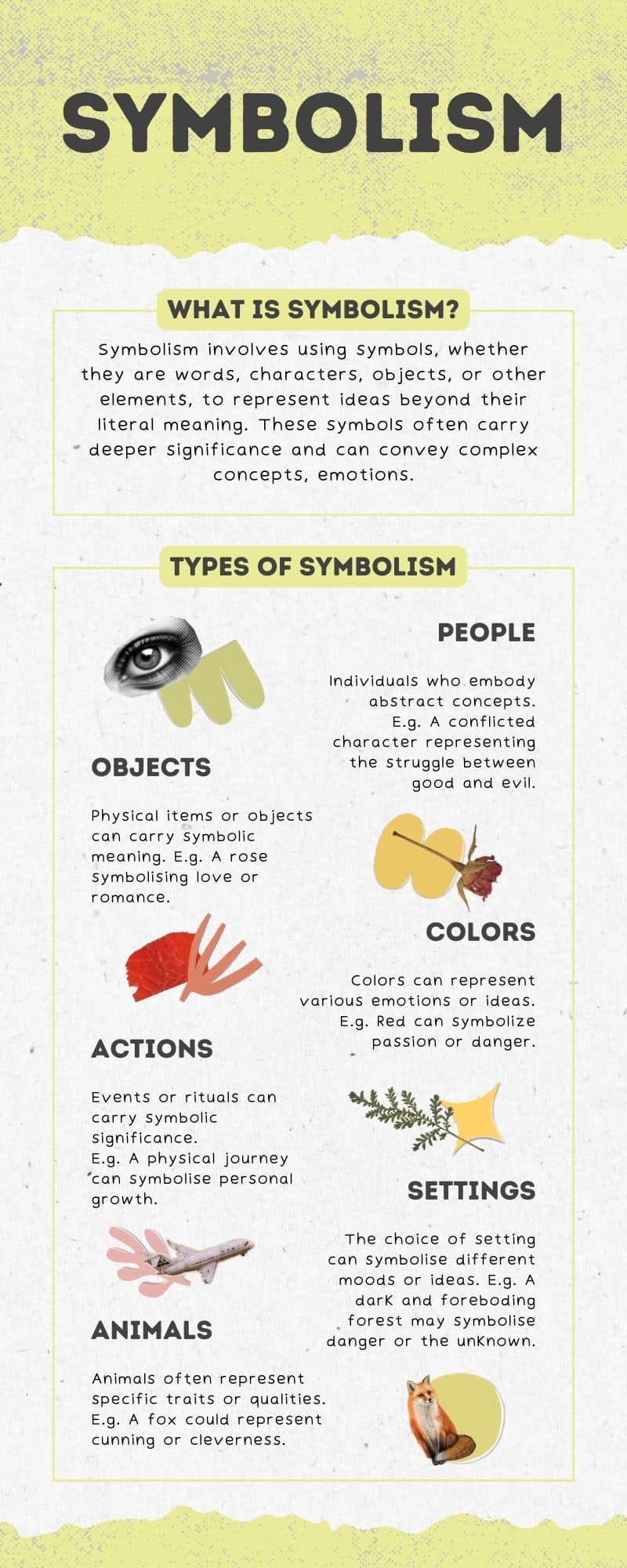
People as Symbols
Historical figures, mythological characters, or contemporary icons often become symbols embodying ideals, virtues, or societal values. These symbolic representations can vary widely across cultures and contexts, reflecting the multifaceted ways in which individuals can inspire and symbolize broader concepts.
- Historical Figures as Symbols: Martin Luther King Jr. symbolizes the struggle for civil rights and the pursuit of equality and justice. Joan of Arc represents bravery, faith, and nationalism in France. These individuals transcend their historical roles to embody certain ideals or movements.
- Mythological Characters as Symbols: Mythological figures are rich in symbolic meaning, representing archetypal qualities and human experiences. For instance, the Phoenix in Greek mythology symbolizes rebirth and renewal, capturing the endless cycle of life, death, and resurgence.
- Contemporary Icons as Symbols: Modern figures can also become symbols, representing specific cultural moments, movements, or changes. For example, environmental activists like Greta Thunberg have come to symbolize the urgency of addressing climate change and the power of youth activism.
Religious Symbols
Religious symbols often encapsulate a faith tradition’s core teachings, divine figures, and eschatological beliefs. They can be deeply complex and sometimes embody multiple layers of meaning and interpretation.
- Symbols of Divine Figures: Many religions use symbols to represent their deities or central figures. In Hinduism, the image of Lord Ganesha symbolizes wisdom, understanding, and a remover of obstacles. In Buddhism, the lotus flower represents purity and enlightenment, qualities associated with the Buddha.
- Eschatological Symbols: Many religions use symbols to represent beliefs about the end times or the afterlife. The crescent moon, for instance, is a general symbol of Islam and reminds believers of time’s cyclical nature and life’s transient nature.
Personal Symbols
Personal symbols are intimately tied to an individual’s identity, experiences, and journey. They are markers of personal history, beliefs, or aspirations and often carry deep emotional resonance.
- Talismans and Charms: Objects that serve as personal symbols of luck, protection, or reminders of personal values. A necklace passed down through generations might symbolize family heritage and continuity.
- Symbols of Personal Achievement: Objects or icons representing personal milestones or achievements. For example, a marathon runner might keep the first pair of running shoes they trained in as a symbol of perseverance and dedication.
- Personal Expression in Art and Writing: Personal symbols often appear in individuals’ creative expressions, whether in the motifs of an artist’s paintings or the recurring themes in a writer’s work. These symbols can illuminate the creator’s inner world, reflecting their thoughts, emotions, and perspectives.
Objects as Symbols
Objects can carry rich symbolic meanings through their inherent qualities or cultural associations. An anchor, for example, symbolizes stability and hope, often representing a grounding presence in one’s life. Similarly, a key can symbolize knowledge, freedom, or the solution to a problem, unlocking new possibilities and secrets.
Color as Symbols
Colors are potent symbols conveying emotions, states of being, or societal associations through their visual impact. Red, for instance, can symbolize love and passion but also danger and aggression, depending on the context. White often represents purity, peace, or mourning, varying significantly across cultures and occasions.
Actions as Symbols
Actions, whether ritualistic or everyday, can function symbolically to convey messages or affirm connections.
A handshake, for example, symbolizes agreement, respect, or greeting, embodying a mutual understanding or pact. In a religious context, baptism symbolizes purification, rebirth, and admission into a faith community.
Settings as Symbols
Settings in literature, art, and real life can embody symbolic meanings, reflecting emotional states, themes, or societal commentary.
For example, a dark, stormy night might symbolize chaos, danger, or internal turmoil, while a serene garden could symbolize peace, growth, and refuge. Settings can subtly influence the perception and interpretation of the narrative or scene.
Animals as Symbols
Animals are imbued with symbolic meanings across cultures, representing traits, emotions, or natural forces. The eagle symbolizes freedom, strength, and the majesty of nature, often associated with visionary leadership or spiritual elevation. The snake, with its ability to shed its skin, symbolizes transformation, healing, or danger, and its interpretation varies widely from one culture to another.
These symbols draw from the well of collective consciousness, personal experiences, and the natural world to convey complex messages in an accessible and often universal language.
Through these categories, symbols weave a rich tapestry of communication, connecting us, our past, and the myriad beliefs and values that define the human experience.
History of Symbolism
The history of symbolism is as rich and varied as human culture, stretching from the earliest forms of human expression to the complex digital symbols of the modern world. Symbolism has always played a crucial role in human communication, bridging the tangible and the intangible, the seen and the unseen.
Prehistoric Beginnings
Symbolism’s roots can be traced back to prehistoric times, when early humans used symbols to represent their experiences and beliefs. Cave paintings, like those in Lascaux, France, are among the earliest examples of symbolic representation.
They feature images of animals, humans, and abstract figures believed to have held significant spiritual or ritualistic meanings. These early symbols were artistic expressions and crucial means of communication and expression for our ancestors.
Ancient Civilizations and the Evolution of Written Symbols
As human societies evolved, so did the complexity of their symbolic systems. The ancient civilizations of Egypt, Mesopotamia, China, and the Americas developed written symbols that went beyond pictorial representation to embody sounds, words, and concepts.
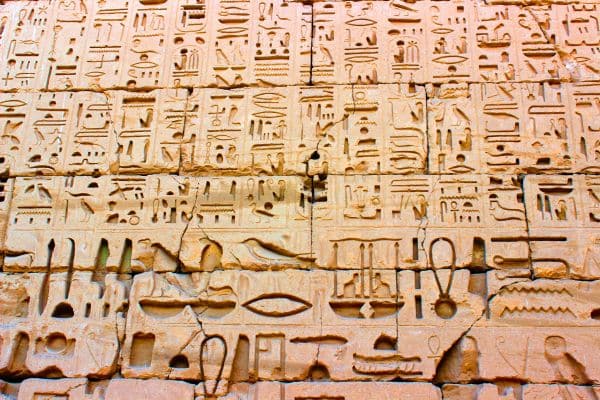
Egyptian hieroglyphs, cuneiform script in Mesopotamia, and Chinese characters are examples of early writing systems that used symbols to record history, religious texts, and administrative records, marking a significant evolution in human communication and culture.
Symbolism in Religion and Philosophy
Symbols have been deeply intertwined with religion and philosophy throughout history. They convey complex theological and philosophical ideas in accessible forms.
In Christianity, the cross symbolizes Jesus Christ’s crucifixion and resurrection, embodying themes of sacrifice and redemption. The yin-yang symbol in Taoism represents the balance and interdependence of opposite forces, reflecting the philosophy’s deep understanding of harmony and balance in the universe.
The Renaissance to Modern Symbolism
The Renaissance saw a revival of classical symbolism, with artists and thinkers employing symbols to convey moral, philosophical, and spiritual concepts. This period also marked the beginning of allegorical symbolism in art and literature, where symbols represented abstract ideas such as virtue, sin, and the human condition.
Symbolism has continued to evolve in the modern era. Movements such as Symbolism in the late 19th century explicitly focused on using symbolic imagery and themes in art and literature to evoke emotions and express the ineffable.
Today, symbolism permeates every aspect of human life, from national flags and corporate logos to the emojis used in digital communication. This reflects the ongoing human need to find meaning and connection through symbols.
Origin of Symbols
Early Human Use of Symbols
The origin of symbols dates back to the very dawn of human civilization, if not earlier. The earliest human societies used symbols as a fundamental means of communication.
Cave paintings, such as those found in Lascaux, France, or Altamira, Spain, serve as a testament to humanity’s primal urge to express and record their experiences, beliefs, and the world around them. These ancient artworks, created thousands of years ago, utilized symbolic representations of animals, humans, and abstract forms to convey complex narratives about survival, spirituality, and the environment.
Evolution of Symbolism Across Ancient Civilizations
As human societies evolved, so too did their use of symbols. The ancient Egyptians developed a sophisticated system of hieroglyphics, where symbols were an artistic expression and a comprehensive written language. Similarly, in Mesopotamia, cuneiform script utilized symbols to record transactions, laws, and stories, laying the groundwork for modern written communication.
In the Americas, the Mayans used glyphs as a symbolic language to record their astronomical observations, religious beliefs, and historical events. Each civilization demonstrates how symbols can transcend mere representation, embodying a people’s collective knowledge, spirituality, and culture.
The transition from using symbols purely for practical communication to incorporating them into religious and cultural practices illustrates the deepening complexity of human thought and society. Symbols became a way to connect with the divine, express the inexpressible, and bind communities with shared meanings and values.
This journey through time shows us that symbols are not merely human inventions but fundamental aspects of human nature. They test our inherent need to make sense of the world and our place within it. As we evolved, our symbols became more intricate and meaningful.
Decoding the Language of Symbols
How Symbols Convey Messages and Values
Symbols carry society’s most profound messages and values, distilled into forms that can be instantly recognized and understood. This encoding of meaning allows symbols to function as a compact form of communication that transcends linguistic boundaries.
For instance, a simple heart symbol encapsulates the complex and multifaceted concept of love, while the dove often represents peace. Symbols convey such messages efficiently because they can tap into the collective consciousness, drawing upon shared understandings and cultural narratives.
The Role of Context in Interpreting Symbols
Context is the lens through which the meaning of a symbol is focused and clarified. The same symbol can have different meanings depending on its cultural, historical, and situational context. The swastika, for example, is a symbol that has represented wellbeing and good fortune in Hinduism and Buddhism for centuries.
However, in the 20th century, its appropriation by Nazi Germany imbued it with meanings of hate and oppression in Western contexts. This duality underscores the critical role context plays in symbol interpretation, reminding us that the meaning of symbols is not static but fluid and dynamic.
Symbols Around Us: In Culture, Religion, and Daily Life
Cultural Symbols and Their Meanings
Cultural symbols are the signposts of a society’s identity, encapsulating the beliefs, values, and traditions that define it. In Japan, the cherry blossom, or sakura, symbolizes the transient nature of life, reflecting the deep-rooted cultural value of mindfulness and the appreciation of fleeting beauty. Similarly, the concept of Yin and Yang in Chinese philosophy represents the balance and harmony of opposites, a fundamental principle that permeates Chinese culture and thought.
Religious Symbols and Their Significance
Religious symbols act as vessels for the sacred, conveying the mysteries and teachings of the divine. In Hinduism, for example, the Om symbol represents the universe’s essence and the interconnectedness of all life. In Christianity, the fish symbol, or Ichthys, was used by early Christians as a secret sign of faith, embodying the teachings and sacrifice of Jesus Christ.
Common Symbols Encountered in Everyday Life
Everyday life is riddled with symbols that guide, inform, and warn us. Traffic signs, with their simple yet universal pictograms, direct the flow of vehicles and pedestrians, ensuring road safety and order.
On a more personal level, clothing brands use logos to signify status, identity, or belonging to a particular group or lifestyle. These symbols saturate our daily experiences, silently communicating messages that, despite their ubiquity, remain vital to society’s functioning.
Symbols in Art and Literature: Beyond the Visible
Artists use symbols to imbue their works with layers of meaning, inviting viewers to engage in a deeper, more introspective dialogue with the artwork.
For example, Caravaggio’s use of light and darkness transcends visual contrast, symbolizing moral and spiritual illumination. In modern and contemporary art, symbols are often used to critique societal norms, question historical narratives, or explore the complexities of human psychology.
The Use of Symbols in Literature to Convey Deeper Meanings
Literature thrives on using symbols to enrich narratives, allowing authors to convey themes, emotions, and concepts with depth and nuance.
In “To Kill a Mockingbird” by Harper Lee, the mockingbird symbolizes innocence and the destruction of innocence, serving as a poignant commentary on the themes of racism and injustice. Through such symbolic storytelling, literature offers a reflective mirror of society, exploring the human condition in its myriad forms.
The Power of Symbols: Influencing Minds and Societies
How Symbols Can Unite or Divide
Symbols possess an extraordinary capacity to both unite and divide. They can serve as rallying points for collective identity and action, encapsulating shared ideals, grievances, or aspirations. The rainbow flag, for instance, has emerged as a powerful symbol of LGBTQ+ pride and rights, promoting solidarity and visibility for a diverse community.
Conversely, symbols can also be co-opted to divide, as seen in extremist groups’ use of flags, emblems, or slogans to differentiate and distance themselves from ‘the other.’ The dual nature of symbols as tools for unity or division highlights their potent influence on social dynamics and collective consciousness.
The Role of Symbols in Movements and Societal Change
Throughout history, symbols have played pivotal roles in movements and societal change, often becoming the visual shorthand for complex ideologies or demands. The clenched fist, for example, has transcended its origins to become a universal symbol of resistance and solidarity among various social justice movements.
Such symbols’ adaptability and enduring relevance underscore their power to encapsulate and communicate a cause’s essence, galvanizing public support and action.
The Modern Digital World: Emojis, Logos, and Internet Icons
The Emergence of Digital Symbols: Emojis and Internet Icons
In the digital era, symbols have adapted to fit online communication needs, giving rise to a new lexicon of emojis and internet icons.
Emojis, in particular, have become indispensable tools for expressing emotion, nuance, and even sarcasm in text-based communication. They enrich our interactions in a medium without traditional tone and body language cues.
Internet icons, from the ubiquitous ‘like’ button to the Wi-Fi symbol, facilitate seamless navigation and interaction within digital spaces, demonstrating how symbols evolve in response to technological advancements.
Corporate Logos: Crafting Identity Through Symbols
Corporate logos epitomize how symbols encapsulate identity, values, and aspirations in a simple, memorable design. Apple’s apple, Nike’s swoosh, and McDonald’s golden arches are more than just brand markers; they evoke specific associations, emotions, and loyalties in consumers.
The strategic use of logos in branding illustrates the power of symbols to create and communicate a brand’s identity, differentiate it in a crowded marketplace, and forge a deeper connection with its audience.
Psychological Interpretation of Symbols
What Science Says About Symbolism and the Human Mind
The study of symbols extends into the world of psychology, where researchers explore how symbols are processed and interpreted by the human mind.
According to Carl Jung’s theory of the collective unconscious, symbols emerge from a more profound, shared reservoir of human experiences and archetypes, tapping into universal themes that resonate across cultures and epochs.
Neuroscience further reveals how symbols’ simplicity and emotional resonance can bypass analytical thought and speak directly to our intuitive understanding, demonstrating symbols’ profound impact on human cognition and emotion.
The Significance of Dreams and Subconscious Symbolism
Dreams are a rich tapestry of symbols, often reflecting our deepest fears, desires, and conflicts in symbolic form. The interpretation of dream symbols has long fascinated psychologists and laypeople, offering insights into the subconscious mind’s workings.
While the significance of specific symbols can vary widely among individuals, the recurring presence of certain symbols in dreams—such as falling, flying, or being chased—suggests common psychological themes and preoccupations. This underscoring of the universal language of symbolism that speaks to our innermost selves reveals the universal language of symbolism.
Symbols in Global Communication
How Symbols Transcend Language Barriers
In our increasingly interconnected world, symbols are critical in transcending language barriers and facilitating universal understanding and communication. Icons like the “no smoking” sign, the universal symbol for recycling, or international airport pictograms provide information and instructions that are instantly recognizable, regardless of one’s native language.
This ability of symbols to communicate across cultural divides underscores their importance in creating a more connected and accessible global society.
The Challenge of Cultural Interpretation and Misinterpretation
While symbols can bridge gaps between languages and cultures, they pose cultural interpretation and misinterpretation challenges.
What is considered a positive symbol in one culture may have negative or entirely different connotations in another. For instance, the color white is often associated with purity and weddings in Western cultures, but in some Eastern cultures, it is the color of mourning and funerals.
This potential for misinterpretation highlights the need for cultural sensitivity and awareness when using or interpreting symbols globally.
FAQs
Addressing Common Questions About Symbols and Symbolism
Can symbols change meaning over time?
Yes, symbols’ meanings can evolve with changing cultural, social, and political contexts. A symbol that once held positive connotations can now represent negative concepts and vice versa.
Are symbols universal?
While some symbols, like mathematical notations and basic emoticons, are nearly universal, most symbols have meanings that vary significantly across different cultures and contexts.
How are new symbols created?
Technological advances, social movements, and cultural shifts often create new symbols. The process involves intentional design and organic evolution as symbols gain acceptance and recognition.
Why are symbols powerful in communication?
Symbols are powerful because they condense complex ideas into simple, memorable forms, enabling quick recognition and emotional connection. They bypass linguistic limitations, speaking directly to our subconscious and evoking shared cultural narratives.
Last Thoughts
Exploiting symbols is a journey without end, offering endless avenues for learning, understanding, and connection. Symbols encapsulate the essence of our collective human experience, embodying our deepest fears, highest aspirations, and most profound mysteries.
As we continue navigating the rich landscape of symbols, we are invited to explore their meanings, stories, and connections.
This journey is about decoding the symbols of the past and participating in creating and interpreting new symbols that will shape our future.
As we share this knowledge and discuss symbols, we contribute to a larger, ongoing conversation that transcends individual perspectives, fostering a more profound sense of connectedness and understanding.
Before You Go
We invite you to share your experiences and thoughts about symbols impacting your life. Have you encountered symbols that left a lasting impression or changed your perspective?
Are there symbols you’ve seen or used creatively to communicate or express yourself?
Join the conversation and explore the fascinating world of symbols together.
Your insights and stories enrich the tapestry of human experience, adding depth and color to our collective understanding of the symbols that shape our world.
More on Symbols
History of Symbols: How Ancient Marks Shape Our Modern World!
From Cave Walls to Emojis—A Journey Through Time Have you ever wondered about the history of symbols? Maybe you’ve wondered about their global variations or how they’ve shaped our world. Prepare to have your curiosity …
Check it Out!Tattoos and Their Secret Powers: How Ink Can Change Your Life!
Exploring the Art, Meaning, and Culture of Ink! Are you intrigued by tattoos? Are you curious about the stories they tell and the intricate details they contain? Look no further. You might be wondering about …
Check it Out!Masonic Symbols Unlocked: Discover the Secret Meanings Behind the World’s Most Mysterious Icons!
The Hidden Powers and Ancient Secrets You Never Knew! Are you intrigued by masonic symbols and their profound meanings? Perhaps you’ve seen the square, compasses, or the all-seeing eye and wondered about their significance? Thankfully, …
Check it Out!Military Insignia: Unlock the Hidden Meanings Behind These Powerful Symbols
From Zero to Hero: Uncover How Military Insignia Define Power and Prestige Are you curious about the meaning behind military insignia or rank emblems? Have you ever wondered about their significance or history? This comprehensive …
Check it Out!More Symbols



